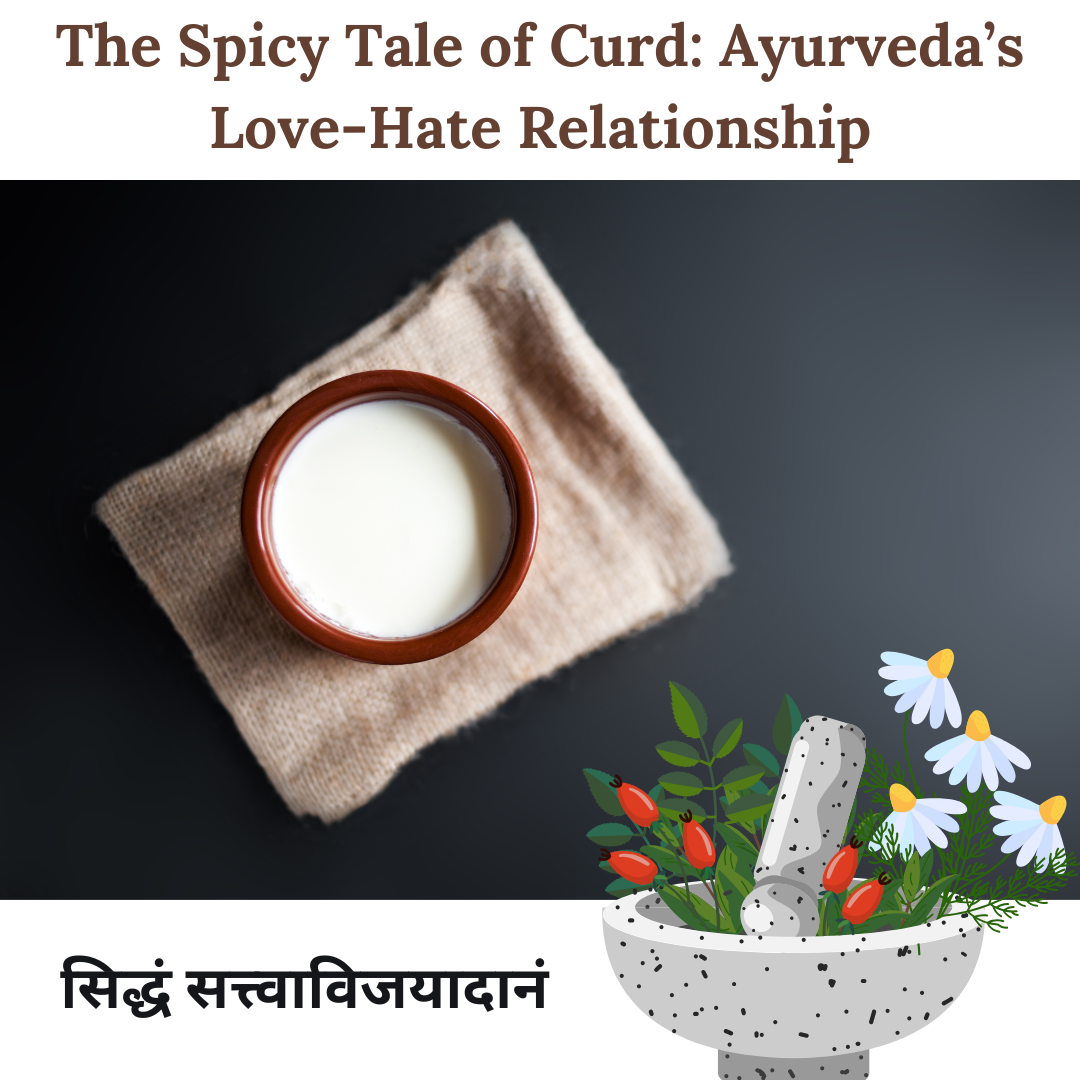The Spicy Tale of Curd: Ayurveda’s Love-Hate Relationship

The milk with colony of the lactobacillus- the curd. Yes the same curd—ever-favourite comfort food for mankind for time immortal—is not only just a delight to the palate; but also it has a complex properties. These properties are detailed in Charaka Samhita (Ch. Su. 27:225-228). Let’s dive into the verses and decode why Ayurveda alternates between loving and criticising this dairy diva.
The controversy around the curd is never discussed in detail. Because the modern day science only looks at the quantitative presence of lactobacilli but doesn’t consider the qualitative approach. Ayurveda specialises in exploring the energy side of the things around us. Here are some main points, I have read.
What Makes Curd So Hot (Literally and Figuratively)?
Aacharya Charaka the master of Ayurveda talks about the curd with beautiful words like – “सिद्धं सत्त्वाविजयादानं” (auspicious and nourishing). Charaka doesn’t stop here, explains in detail about this creamy delight:
- “रोचनं दीपनं वृष्यं…”
Translation: Curd is a improves appetite (rochana), helps in digesting the food easily (deepana), and improves vitality (aphrodisiac).
When you don’t feel to eat-curd helps in this condition of low appetite and adds to the delicacy of the food. Eating food is not enough, there should be something which can help to digest the food, curd helps in this too. It improves vitality, gives a sensuous feeling and kicks the hormones. - “…अम्लं उष्णं वातघ्नं मङ्गल्यं बृंहणं…”
Translation: It’s sour but hot in potency, a vata-pacifier, and brings good vibes, improves weight (helps in weight gain).
The snowy white curd is always “sour” (even it tastes sweet to your tastebuds) and amazingly “hot” in nature (not so snowy). These two characters make it a choice to pacify the Vata dosha. Because it slows down the system-it brings satisfaction and also adds on to weight. - “…पीनसे च अतिसारे च…”
Translation: It helps in curing runny nose (rhinitis) and also controls the loose motions.
You might have heard a lot your mumma and grandma saying that it is running nose- don’t take curd. This is not correct. The encyclopedia of health Charak samhita says- it cures Running nose (Rhinitis). It sounds strange!! But not!! The science was with Aacharya. He knew the lactobacilli too i.e. why he says- it cures Diarrhoea too.
No need to doubt the master!
When Curd Plays the Villain
None and nothing is absolute. Absolutely good!! When taken in right way, right quantity and right manner- only then the goodness works, otherwise the nectar can also prove poisonous. योगादपि विषं तीक्ष्णमुत्तमं भेषजं भवेत् ……….भेषजं चापि दुर्युक्तं तीक्ष्णं सम्पद्यते विषम् Charaka clears in first chapter only.
Like every hero in a story, even curd has its flaws. While it’s easy to fall in love with its creamy texture and tangy taste, Ayurveda gently reminds us not to overdo it. Think of it as a cautionary tale: too much of a good thing can lead to trouble. Verse 227 comes to the rescue with its timeless wisdom, reminding us that balance is key—even with something as delightful as curd.
- “शरद्ग्रीष्मवसन्तेषु…”
Translation: Curd is not for the three seasons- Autumn, summer and spring.
You can not wear woollens in summer, these bother the skin so strongly not advisable to use the “hot” curd in summers. So is applicable during the autumn and springs. Who else other than Ayurveda can talk about in such a deep understanding of a small bowl of the curd!! - “रक्तपित्तकफोत्थेषु…”
Translation: Bleeding disorders, Pitta imbalance, Skin disease and where blood is vitiated- a big no to curd, and if Kapha is not in harmony then also say no to curd.
How something hot can vitiate the cold Kapha- it does through its capacity to slowdown the metabolism and occlusion of the channels so don’t use it for Kaphaja vikar like Diabetes etc. (Spoiler: Running nose has mucus not Kapha- Ayurveda is a bit deeper than it sounds). Where blood has some pathological role- avoid Curd. Curd might block the process of Cure.
Curd’s Split Personalities: Fresh vs. Fermented
Verse 228 takes us into the nitty-gritty details. Imagine curd as a moody artist:
- “त्रिदोषं मन्दकं जातं…”
Translation: Unripe curd? It’s all drama, aggravating vata, pitta, and kapha alike.
The quick-curd-making-machines are far more dangerous than your pollution and global warming. Because Ayurveda has a lot to say about this. The unripe curd (not settled overnight and specially in a clay pot) will vitiate all the three doshas and can lead to serious conditions like- autoimmunity or some other complex conditions. - “…श्लेष्मानिलघ्नस्तु मण्डः स्रोतोविशोधनः…”
Translation: The whey, though, is a cleanser extraordinaire, keeping your channels squeaky clean.
From the detail of complex disease causing nature of the curd, you might have thought it is exaggerated. No. Because Charaka was aware about the whey part of the curd. It cleans the channels unlike the curd’s inherit nature and it also reduces the Kapha.
The Ayurveda Cheat Sheet for Curd Lovers
- Eat Smart, Not Randomly:
Skip curd in summer, spring, and autumn unless you’re itching for an imbalance party. - Know Your Dosha:
Vata types, curd is your jam (er, yogurt). Kapha types, proceed with caution. Pitta aggravates and Rakta vitiates. - Play It Cool:
Always pair curd with something warm like moong dal or spices to mellow its kapha-kicking tendencies.
Curd’s Comeback: The Final Scoop
This is not alone about curd. It is about Ayurveda. Don’t look at the scoop-depth of curd bowl. It is deeper than that. The influencer based Ayurveda is harming not only Ayurveda but also health of everyone. This tale of curd is just an example. I will keep on coming with such examples.
Ayurveda’s take on curd is like the ultimate rom-com: love, conflict, and lessons for life. It’s the embodiment of balance—consume it wisely, or face its wrath. So, whether you’re downing it in lassi or sneaking it into a curry, remember: Curd is life. But too much curd? That’s a life lesson.














